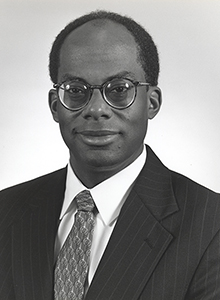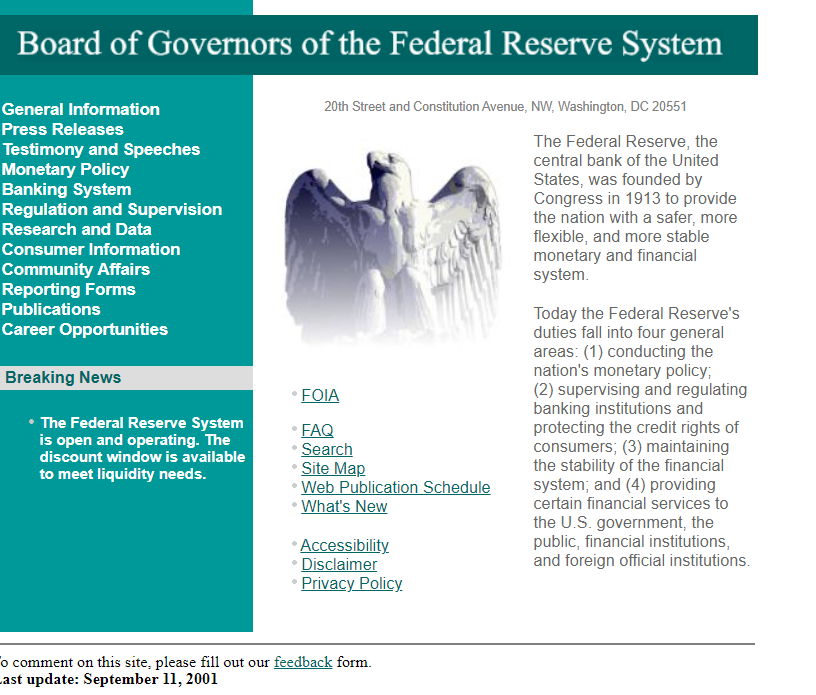The Federal Reserve's Response to the September 11 Terrorist Attacks
September 11, 2001

Image from the Federal Reserve Bank of New York 2001 annual report
The terrorist attacks on Tuesday, September 11, 2001, were a major shock to the United States and the world.1
Hijacked passenger jets crashed into the Twin Towers of the World Trade Center, causing the deaths of nearly 3000 people as well as widespread destruction in New York’s financial district. Near Washington, DC, a third plane hit the Pentagon, causing further loss of life and disruption. A fourth plane crashed in the Pennsylvania countryside as the passengers attempted to seize back control from the hijackers.

In New York, buildings near the World Trade Center were destroyed or badly damaged, and power and communication infrastructure was devastated. In addition, lower Manhattan was covered in dust and ash, fires at "ground zero" took weeks to be extinguished, and the area was closed to traffic for more than a month. As a consequence, key financial markets and institutions were unable to operate, in some cases for days. It was clear that if these strains were not effectively addressed, knock-on effects could impede other financial centers and institutions and ultimately the broader US economy. These risks were a direct challenge to the Federal Reserve, given its multiple roles in payment systems, banking supervision, liquidity provision, and monetary policy, as well as its broader responsibility for financial stability.
The extent of the dislocations for financial markets and institutions varied, depending on the situation at the time of the attacks and the location of key market players:
- Trading in the US government securities market starts early in the day, and it had been underway for some time when the attacks began. Some market participants lost their lives, and many firms that were not immediately affected were unable to operate given the damage to facilities and infrastructure in New York City.2 Billions of dollars of trades had been executed, but not yet reconciled. The main clearing banks for government securities, Bank of New York and J.P. Morgan Chase, were located near the World Trade Center and had to move to backup facilities, which posed massive logistical difficulties and took considerable time and effort. The result was that buyers and sellers of securities did not know which of their trades had been completed and which had not—leaving them uncertain about their positions and, so, also their funding and hedging needs. The final reconciliation of trades was not completed for weeks.
- The New York Stock Exchange (NYSE) had not yet opened when the attacks began, but its building was damaged in the attacks, and power and telecommunications lines were severed. Other exchanges in the area were also disrupted. Temporary repairs to infrastructure were not completed until early the following week, and trading on the New York Stock Exchange did not resume until Monday, September 17.
- Given the ongoing power and telecommunications problems, even banks and other financial institutions in the area that were not directly affected by the attacks could not connect with markets and counterparties. Some were not able to access their accounts at the Federal Reserve. Even as backup systems came online, some banks were unable to make payments because they had trouble connecting their backup systems to the Fed’s Fedwire payment system, the backbone of the US payment system. And the failure of one bank to make a payment could leave other banks that would have received the payments unable to make payments themselves, causing knock-on effects across the financial sector. The number of Fedwire payments fell by more than 40 percent on September 11, and the value of those payments fell by a quarter.
- In addition, the usual flow of checks to clear payments across the banking system was disrupted. At the time, the Federal Reserve moved checks between Federal Reserve districts by plane, and in the aftermath of the attacks the Federal Aviation Administration (FAA) grounded all US air traffic. The result was that the Federal Reserve couldn’t present checks to issuing banks for payment, potentially leaving receiving banks short of funds.

Against this backdrop, the Federal Reserve had a number of key decisions to make regarding both its own operations and the operations of critical markets and financial institutions. The situation was made more difficult for the Fed by the fact that six of the seven members of the Fed’s Board of Governors were traveling at the time and could not be reached. Vice Chair Roger Ferguson was the only member available that day. Chair Alan Greenspan was on a commercial jet returning from international meetings in Basel, Switzerland, and his plane had to return to Zurich because of the FAA decision to shut down US airspace. The president of the New York Fed, William McDonough, had attended the same meetings as the Chair. As a result, both Greenspan and McDonough were not able to communicate with Ferguson until late in the afternoon.
Despite these logistical complications, Vice Chair Ferguson, in consultation with Reserve Bank presidents and staff around the Federal Reserve System, moved quickly to use the Fed’s authorities to help manage the situation. These decisions were made in an environment of uncertainty and fear. As Ferguson noted when looking back at the events, "The Federal Reserve System had to cope effectively in a threatening environment. The employees of the Federal Reserve Bank of New York, being a few blocks away from "ground zero," had the exceedingly difficult challenge of maintaining operations in the midst of terrifying and chaotic surroundings. All parts of the Fed System, wherever located, faced the challenge of maintaining ongoing operations…in the period of heightened uncertainty that followed those horrific attacks." (Ferguson, 2003).
The first key step was to communicate to financial firms, financial market participants, and the public that the Fed itself was not incapacitated by the attacks and could provide guidance and assistance to help support financial stability. Soon after the attacks in New York, at 9:44 am, the Fed issued a statement to banks over the Fedwire system stating that the Federal Reserve was "fully operational at this time and will remain open until an orderly closing can be achieved" (Lacker, 2003). After a call with Reserve Bank presidents, Vice Chair Ferguson decided to issue a short public statement that morning, rather than wait for additional information to become available. The statement simply reported that:
The Federal Reserve System is open and operating. The discount window is available to meet liquidity needs. (Federal Reserve, 2001)

The next step was to try to ensure, where possible, that the financial sector would continue to operate and provide needed services to the economy. Some in the government thought that, in light of the confusion and disorder following the attacks, the President should declare a bank holiday—that is, close the entire banking system to allow a greater focus on recovery operations. Vice Chair Ferguson pushed back sharply on the idea, suggesting that a bank holiday would potentially sow panic by making citizens unsure if they would be able to get their money from their bank, likely worsening the crisis. In the end, no bank holiday was declared. Meanwhile, the Fed was working hard to keep the Fedwire system operating, despite the telecommunications breakdowns in Manhattan. In some cases, this required a manual bypass of the system, under which individual bankers spoke with staff at the New York Fed by phone, often on their personal cell phones, and submitted the payments that their institutions wanted to make. Then the New York Fed staff would put those payments directly into the system. With air transport of checks suspended, the Fed decided that, to avoid cascading effects on bank funding, it would continue to pay banks as usual when they submitted checks for clearing, despite the potentially significant delay in collecting from the issuing banks. This approach implied a sharp increase in "float"—the difference between the amount the Fed paid to receiving banks and the amount it obtained from the issuing banks. Float had averaged $766 million per day in the first eight months of the year, but it spiked to $28 billion in the days after the attacks.
Despite the increase in float, many banks and other financial institutions were short of liquidity because of the problems with payments that the attacks caused. As a result, the Fed used its power as "lender of last resort" to lend funds to financial firms using a range of tools. The most important tool initially was the discount window. As noted in the Fed’s public statement, the discount window was available, and the Fed provided credit against a wide range of collateral to banks that found themselves short of funds and could not access money markets. Discount window credit had generally run under $1 billion in the period prior to the attacks, but lending spiked to about $46 billion on September 12.
Another way to provide liquidity to institutions with cash needs was to conduct open market operations with large broker-dealer firms—in particular, temporary purchases of government securities, called repurchase agreements—to make funds available to markets. Starting on September 12 and continuing until September 17, staff at the trading desk at the Federal Reserve Bank of New York, operating from their backup facility in New Jersey, conducted daily open market operations at the target federal funds rate, meeting all demands from their counterparties. Even with the liberal use of the discount window and open market operations, some institutions were still unable to obtain the liquidity that they needed and, so, ran temporary overdrafts of their Federal Reserve accounts. Such overdrafts were about one-third higher than usual over the 10 days after the attacks. To ease the pressures on such firms, the Fed waived the usual overdraft fees.3 Finally, some of the banks that faced liquidity pressures during this period were foreign banks that had only limited collateral in the United States to back discount window borrowing. To allow these institutions to potentially use foreign collateral to meet their dollar funding needs, the Fed used its authority to intervene in foreign currency markets to establish swap lines with the European Central Bank, the Bank of England, and the Bank of Canada. These swap lines allowed the foreign central banks to swap their own currencies for dollars with the Fed, and then on-lend the dollars to banks in their jurisdictions to help them meet their dollar funding needs. While these swap lines were not heavily used, they provided confidence that dollar funding needs could be met, even for foreign institutions.
Despite these strong actions by the Federal Reserve, there remained a concern that banks, facing uncertainty and funding pressures, could pull back from lending, thereby undermining economic growth. To address this possibility, the Fed, along with the other federal banking agencies, issued a statement on Friday September 14, noting that bank balance sheets might increase in size as a result of the attacks, if borrowing by customers increased or their deposits rose. If banks were concerned that these increases would reduce their capital ratios relative to regulatory norms, they were urged to talk with their supervisors about ways that the problem could be addressed (Board of Governors et al., 2001). The implication was that banks should not pull back from serving their customers because of temporary balance sheet strains resulting from the attacks and that supervisors would provide flexibility to allow banks to do so.
The Federal Open Market Committee, the monetary policy decision-making body of the Federal Reserve, eased monetary policy significantly to ease pressures in funding markets and help to support the economy: They cut the target for the federal funds rate by 50 basis points before the opening of business on Monday, September 17.
In the end, these actions, along with those taken by other government agencies, private firms, and individuals, were effective. The functioning of financial markets and institutions normalized over the subsequent days, and significant spillovers to the broader US economy were avoided. This good outcome was not preordained, however. As noted by Vice Chair Ferguson, the Fed’s effective response to the attacks reflected the multiple roles that it plays in payments, supervision, liquidity provision, and monetary policy (Ferguson, 2003). These broad authorities give the Fed a powerful toolkit to use to address the wide range of pressures that emerge in times of crisis. Since 2001, the Fed has called on these tools to an even greater extent to address the global financial crisis in 2007-09 and the COVID pandemic in 2020.
Endnotes
- 1 This essay summarizes the material in Rosenthal, English, and Elias (2020) with additional information from Lacker (2003) and Ferguson (2003). In addition, see the interview with Roger Ferguson in the Federal Reserve Board Oral History Project (2006) and General Accounting Office (2003).
- 2 Hardest hit was the securities firm Cantor Fitzgerald LLC, which was located near the top of the North Tower of the World Trade Center. Of its 960 New York employees, 658 were lost on September 11.
- 3 The Federal Reserve also allowed overdrafts by Federal Home Loan Banks affected by the attacks. The Home Loan Banks were not eligible for discount window loans, which are available only to banks and other depository institutions.
Bibliography
Board of Governors of the Federal Reserve System, Federal Deposit Insurance Corporation, Office of the Comptroller of the Currency, Office of Thrift Supervision (2001). "Joint Interagency Statement," September 14, 2001. Available on FRASER
Federal Reserve (2001). "Press Release," September 11, 2001. Available on FRASER
Federal Reserve Board Oral History Project (2006). "Interview with Roger W. Ferguson, Jr." Available on FRASER
Ferguson, Roger W., Jr. (2003). "September 11, the Federal Reserve, and the Financial System," Speech at Vanderbilt University, Feb. 5. Available on FRASER
General Accounting Office (2003). "Potential Terrorist Attacks: Additional Actions Needed to Better Prepare Critical Financial Market Participants," Washington, DC: U.S. General Accounting Office. Available on FRASER
Lacker, Jeffrey M. (2003). "Payment System Disruptions and the Federal Reserve Following September 11, 2001," Federal Reserve Bank of Richmond Working Paper 03-16, December 23, 2003. Available on FRASER
Rosenthal, Jean, William B. English, and Jaan Elias (2020). "The Federal Reserve Response to 9-11," Yale School of Management Case Study #20-029. Available online
Written by William B. English as of September 10, 2024. Please cite this essay as: William B. English. "The Federal Reserve's Response to the September 11 Terrorist Attacks." Federal Reserve History, September 10, 2024. See disclaimer and update policy.

